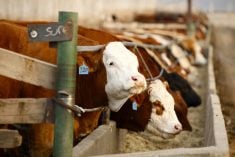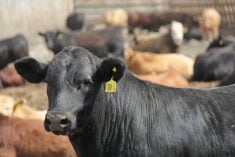Western Canadian feeder cattle prices were solidly $3 to $5 higher on average this past week compared to seven days earlier. Improved beef demand has drawn down stocks in the production pipeline, allowing packers to increase bids for fed cattle.
Alberta packers were buying fed cattle in the range of $201 to $202, up $2 from earlier in May. U.S. wholesale choice beef prices edged up $6 per hundredweight (cwt) this week to historical highs reaching $262/cwt. Feedlots now feel more comfortable that the fed market will hold value through the summer months, which rejuvenated buying interest across all weight categories. This will be the second year that we see a counter seasonal trend in the fed cattle market as consumption improves on the heels of the expanding economy.
Read Also

U.S. grains: Soy futures post biggest monthly gain in nearly five years on China trade optimism
U.S. soybean futures climbed to a 15-month high and posted their biggest monthly gain in nearly five years on Friday following a rally fueled by the prospect of revived exports to China.
Certain backgrounding operations were liquidating the last of fall placed calves which is impeccable timing given the overall environment. Larger strings were aggressively bid as feedlots scour the Prairies for quality parcels. Southern Alberta buyers saw 620-pound lower-flesh larger-frame Charolais-based steers trade near $323. Prices were relatively even across all Prairie regions and lighter weights under 600 lbs. continued to percolate higher, trading $10 above week-ago levels in some cases.
Cow-calf pairs are astronomical value readily trading in the range of $4,200 to $4,500 and certain auction markets reporting up to $5,000. Bred cows are in the $3,000-$3,500 range because these assets now reflect the present value of future earnings. Cow-calf operator margins have exceeded $400 per head this past year, building equity for expansion. Higher prices can cause sellers to back away from the market; therefore, the cow-calf operator who wanted to retire may hold on one or two more years, especially if his son is back home from the oil patch.
Feed grain values were under pressure this week, with feed barley trading at $202 per tonne delivered in the Lethbridge area, down $10 per tonne from two weeks earlier. Feed wheat dipped under $200 per tonne in the same area. Farmers are holding a fair amount of lower-quality grains that need to move before the end of the crop year.
— Jerry Klassen is a commodity market analyst in Winnipeg and maintains an interest in the family feedlot in southern Alberta. He writes an in-depth biweekly commentary, Canadian Feedlot and Cattle Market Analysis, for feedlot operators in Canada. He can be reached by email at [email protected] for questions or comments.












